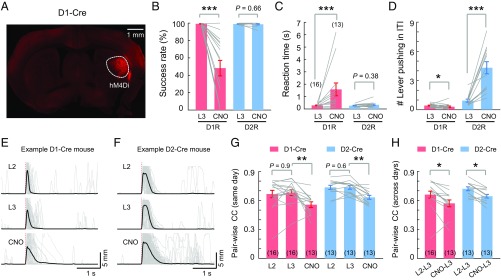Fig. 7.
Distinct effects of selective silencing of D1R or D2R neurons. (A) Fluorescence image of a brain section from a D1-Cre mouse with a Cre-dependent hM4Di-expressing viral vector in the DLS. Success rates (B), reaction times (C), and number of lever-pushing events during the ITI (D) are shown in D1- and D2-Cre mice expressing Cre-dependent hM4Di on the last day (L3) of learning and on the next day with CNO administration. Gray lines connect data from the same mouse (D1-Cre, n = 16 mice, except those indicated in parentheses; D2-Cre, n = 13 mice; *P < 0.05, ***P < 0.001 by Wilcoxon rank sum test). Traces depicting lever movement trajectories from one example hM4Di-expressing D1-Cre mouse (E) and one example hM4Di-expressing D2-Cre mouse (F) on L2, L3, and the CNO injection day are shown, demonstrating that highly stereotyped movement trajectory on L2 and L3 were impaired after CNO injection. (G and H) Pairwise CCs of movement trajectories between single-trial trajectories within the same day and between two different days (number of mice used for analysis are indicated in parentheses). Significant effects of CNO treatment on movement trajectories were found for both D1-Cre and D2-Cre mice (D1-Cre, n = 16 mice, except those indicated in parentheses; D2-Cre, n = 13 mice; *P < 0.05, **P < 0.01 by Wilcoxon rank sum test).

